Ancient Villages
Ancient Villages in Yunnan
Dali Sideng Street of Shaxi Old Town in Jianchuan County travel guide introduces the main attractions, entrance tickets booking, The best time to visit, How to Get there, the highlights, facts, history, photos, weather, accommodation, visiting routes, travel tips, tour maps of Sideng Street of Shaxi Old Town in Dali(寺登街).
Sideng Street(寺登街) is located in Shaxi Town, south of Jianchuan County, Dali Prefecture. It is the important hub of the Ancient Tea and Horse Road. Known as the only market of the Ancient Tea and Horse Road, it was entitled as the World Monumental Architecture Heritage in 2001. From the Neolithic Age to Ming and Qing dynasties, Shaxi was the center for business and exchange between central China and Tibet. Tibetan people carried the furs and herbs and exchanged the rare but necessary things like salt and tea. With the prints on the road, Sideng Street carries the splendid culture of the ancient road and proved the prosperous business here.
In Tang Dynasty around 700 AD, Shaxi was founded as a trading point at the Tea Horse Road. People of the town not only sold a wide variety of homemade items at that time, but also opened their house and offered food to the passing caravans. Due to the prosperity of their business, the families renovated their house. The improving of living conditions then attributed to the flourishing of arts and centuries-old traditions. The meticulously kept houses decorated with family motto plaque and exquisite wooden carving products witnessed the affluence of Old Shaxi and Shaxi people. However, with the decline of the trade along the Tea Horse Road, Shaxi vanished from the sight of public, only the surviving Friday Market continued its vigor.
Shaxi at dusk likes a colorful oil painting. With several pieces of flaming cloud in the sky and mountains in the surrounding, the rays of the sunset slanted in streams through the trees. The shinning Heijiang flows through the dam from north to south. Mountain, river, Bai ethnic country, the red walls and green tile with trees around make up an amazing picture.
The street was built at the end of the Yuan Dynasty and the beginning of the Ming Dynasty. However, the history of the Shaxi area can be traced back to the Spring and Autumn Period in the Western Han Dynasty. The bronze ware was unearthed from the ancient tomb of the Aofeng Mountain in the south of the city. The transaction of the currency with the shellfish already existed in that time.
Sideng Street located in the center of plain on the dam, with tall Aofeng Mountain(鳌峰山) in one side and clear Heihuijiang(黑惠江) in the other side. In the ancient times, here used to be an important post-house of Ancient Tea Route and “Southwest Silk Road”, going straight towards north to Zhongdian— a hinterland of Sichuan-Tibet; going towards south through west side of Cangshan to Yellow River Plain. World Monument Fund believed that “China Shaxi Sideng Street district is the only country fair along the whole Ancient Tea Route.” All of these show that Sideng had a long and profound history, and witnessed the commercial communication between people.
Walking into Sideng Street, the sunset in the street consist of a quaint and mysterious street view. The aged red flagging stone road shows years of vicissitudes. Surrounded by trees, either side of street are lined with old shops built in Bai ethnic style which is store in the front and yard in the back. Travelers can get into several vernacular dwellings and appreciate carved architecture of Bai ethnic.
Coming to central downtown, Square Street(四方街) will catch your eyes. The square street here is larger than Square Street in Lijiang. There are old shops around Square Street, and two old locust trees are in the central which give some shade to people. In the south side, there is an old opera stage(戏台) in the central of three-floors building of aquatint. Square Street is the bustling place here; you can buy some special products here. Though the whole market is full of people, it is different from other places, the tradesmen here is unhurried. During Every fifteenth of February, Torch Festival, people come here to watch opera.
In the west of Square Street, there is a grand temple, Xingjiao Temple(兴教寺), which is the only Azhali(阿吒力) Buddha temple of Ming Dynasty. Standing in this temple, accompanied by the seeting sun and cypress, it seems that you can hear a Sanskrit song.
When the weather is fine in Dali, the sunshine is heated, and ultraviolet light is strong. People should avoid direct sunlight, and the sun hat preparation is required during outdoor activities, a pair of sunglasses will make you comfortable in the trip.
Shaxi Old Town, Dali
Xingjiao Temple in Shaxi Old Town, Dali
Yujin Bridge in Shaxi Old Town, Dali
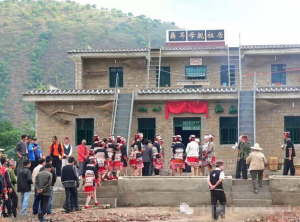
Honghe River(It is called Moshajiang river in Mosha Town of Xinping County) comes from the north, and all the way south to Ailao mountain, alluvial out a lot of fertile lands along the river platform. These platforms are located in the deep valley with hot weather. Because of lush vegetation and good light and heat conditions, they are rich in rice, mango, banana, pineapple and other products, can be called as the Xanadu of agrarian age. As early as thousands of years ago, there was a mysterious ancient Baiyue ethnic group百越民族 migrated and settled here. They dressed in gorgeous costumes, dyed the gold teeth, believed all things have spirits, and claimed to be the royal descendants of ancient Dian kingdom. After thousands of years, gradually, they extended to Jiasa Town of Xinping County新平县戛洒镇 in the north and the narrow river valley in Yuanjiang County of Yuxi玉溪元江县 in the south, formed a cultural peculiar “Huayao Dai ethnic corridor花腰傣民族走廊”. There are hundreds of Huayao Dai villages in all size distributed on this corridor, Nanhao village南薅村 is one of them.
Nanhao village南薅村 is a very small village, with 40 families and 168 people. They are all Huayao Dai people. The village is surrounded by streams and rivers. The environment is elegant and clean, and the village is clean and tidy. Almost all the houses in Nanhao Village are typical Huayao Dai traditional architecture, Tuzhangfang土掌房(Earthen House), which has a solid structure and flat roof. The biggest advantage is warm in winter and cool in summer. If properly maintained, they can stand at least 100 years. Most of Tuzhangfang houses in Nanhao Village look old. In recent years, as the villagers become richer, a small number of villagers have begun to renovate or build new houses, but the new buildings still follow the ancient style. As a whole, Nanhao village is still a rare and original Huayao Dai traditional village.
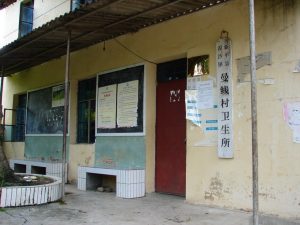
Although Nanhao Village南薅村 is thought to be one of the ancient Huayao Dai花腰傣 villages in Xinping新平, because there is no written language in the history of Huayao Dai, it is impossible to verify when the village was built. All the cultural traditions of Huayao Dai are still preserved in the Nanhao Village. And different from the Dai minority in Xishuangbanna西双版纳 and Dehong德宏, Dai people in Nanhao Village worship natural totem, advocate primitive religion of everything has their spirits, so they don’t believe in Buddhism. You can’t see the pagoda in the village, but you can see sacrifice trace under the big banyan tree, the advocation of all things have spirit faith has been prevalent among the Baiyue ethnic people in the ancient time. Up to now, Huayao Dai people still regard it as an important part of daily life.
In 2010, Nanhao village南薅村 was listed as a special tourist village in Yunnan province. In 2013, it was listed as a special cultural tourism village of ethnic minorities in Yunnan province again. At present, all roads in the village have been hardened, the folk culture museum has been taken on a new look, some of the traditional Tuzhangfang 土掌房buildings have been effectively protected. The village is close to the main road of traffic, and more and more tourists have paid attention to this small village with strong flavor of Huayao Dai.
Nanhao南薅 means pure water in Dai language. Nanhao Village is a village with the administration of Manxian Village曼线村 Committee of Mosha Town漠沙镇 in Xinping county新平县, located in the southeast of Mosha Town and the west bank of Moshajiang River漠沙江. It is 440 meters above the sea level, and highway runs through the village. Nanhao village is 20 kilometers from Mosha Town, 84 kilometers from Xinping County, 182 kilometers from Yuxi City and 270 kilometers from Kunming, the provincial capital of Yunnan Province.
There are 6 non-stop buses a day from Kunming to Xinping County. Then another 2 hours and a half drive needs to spend from Xinping county新平县 to Nanhao Village南薅村. Of course, you can also take the regular bus from Xinping bus terminal to Mosha town漠沙镇, then go to Nanhao Village by chartered bus.
Kunming-Xinping County
Departure Time: 8:30, 10:00, 11:00, 12:00, 14:10, 16:30
Ticket Price: 73 CNY
Distance: About 180 kilometers
Consume Time: About 2.5 hours
Here are several recommended hotels in Xinping County.
1. Shiguang Xiaozhu(Golden Time) Hotel新平时光小筑酒店
Address: Jiaxia Avenue, Jiasa Town, Xinping County, Yuxi玉溪新平县戛洒镇戛洒大道
Tel: 18887730188
Starting Price: 115 CNY
2. Nature Outdoor Villa新平大自然户外农庄
Address: Daha Liangzi, Daha Village, Jiasa Town, Xinping County, Yuxi玉溪新平县戛洒镇达哈村达哈梁子
Tel: 15758024198
Starting Price: 93 CNY
3. Xinping Ailao Mountain Hotel新平哀牢山酒店
Address: The Middle of Jiasa Avenue, Jiasa Town, Xinping County, Yuxi玉溪市新平县戛洒镇戛洒大道中段
Tel: 0877-7393878
Starting Price: 111 CNY
1. Respect and learn Huayao Dai culture;
2. Transportation to Nanhao village is convenient.
Dongchuan Red Land is located in Hongtu Town (红土地镇), over 40 kilometers southwest of the Dongchuan District (东川区) in Kunming (昆明市). Within this region lies Huashitou (花石头), near the 109-kilometer milestone. This area encompasses nearly a hundred square miles and showcases the most concentrated, typical, and distinctive red earth found on the Yunnan (云南) Red Plateau.
From September to December each year, the landscape transforms as part of the red land is turned over and prepared for planting. Another section is already sown with lush barley or wheat and other crops. From a distance, this vibrant patchwork of color appears to be painted by the heavens, displaying an array of dazzling hues against the backdrop of blue skies, white clouds, and ever-changing beams of light. This combination creates a spectacular view that defines the essence of the red land.
Huashitou Village serves as the heart of the Red Land. The name Huashitou translates to “colorful stones,” which are found abundantly throughout the village, earning it the affectionate moniker of “colorful stone” among the locals.
These colorful stones maintain their elegant appearance throughout the year:
While Huashitou Village is not large, it is nestled within the Red Land Scenic Area (红土地景区) and is renowned for its unique geological features. The village is abundant in agate (玛瑙), which hides within hard pebbles. When illuminated by sunlight, these stones radiate a dazzling array of colors, leading locals to refer to agate as “colorful stones.” This is how the village derived its name.
Numerous legends surround the existence of these beautiful stones in such a highland area. The most plausible explanation suggests that they were once submerged at the bottom of a river. After geological changes elevated the plateau, the agates surfaced naturally. This phenomenon can be considered a precious gift from nature to humanity.
The beauty of Huashitou Village is accentuated by its concentration of the reddest and most stunning soils in all of Dongchuan. Photographers and artistic souls are enamored with this site, establishing numerous photography bases in the area.
The red land reaches its peak splendor after rainfall, when the soaked soil appears even more vibrant under the sun. The harmony between the red earth and the village creates a secluded paradise, enticing visitors to approach and explore further.
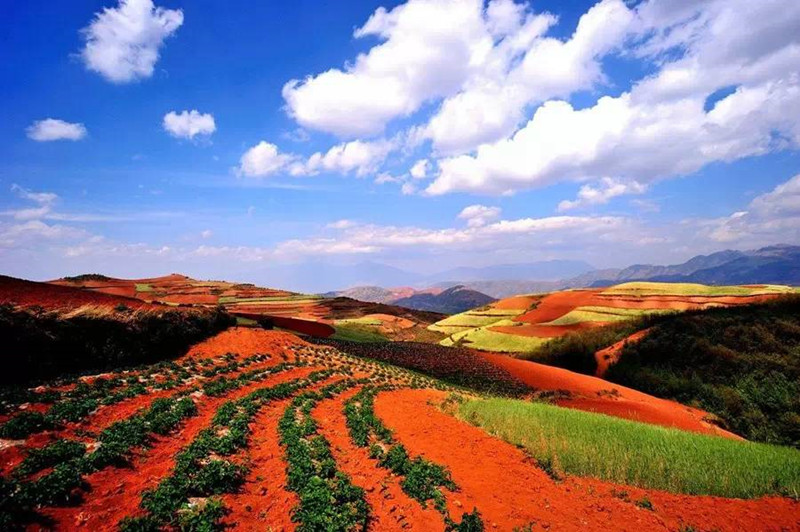
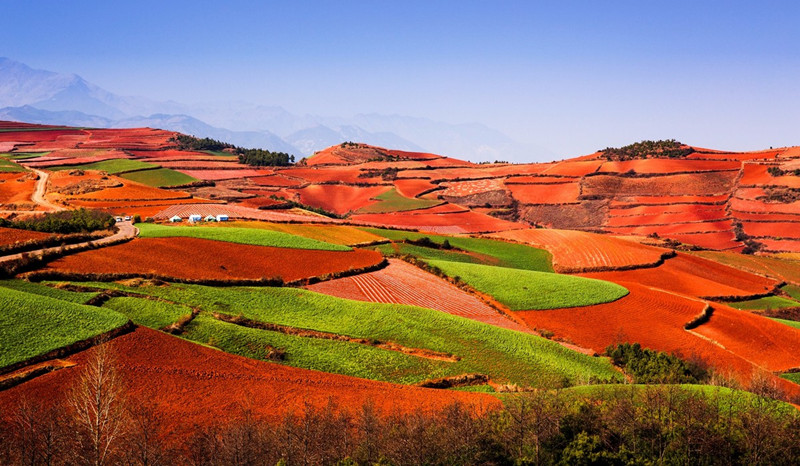
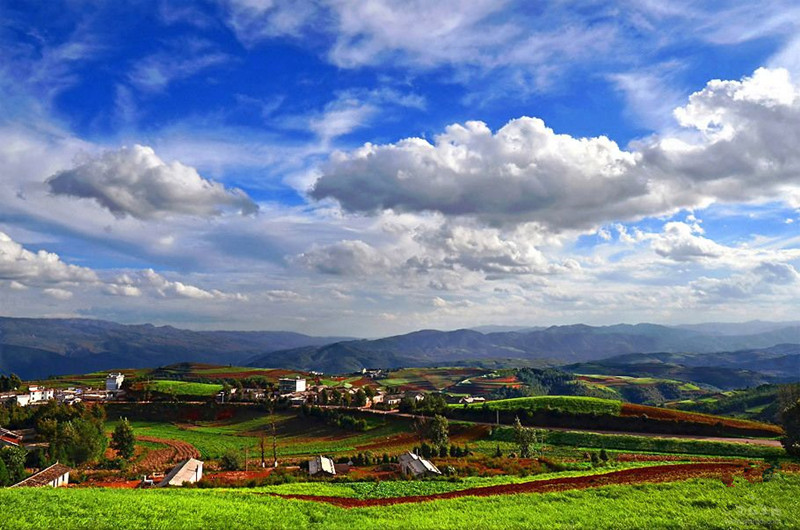
Plan your Kunming Ethnic Villages Tour to Kunming? Visit Hemo Village in Shilin County, Kunming which is one of the most fascinating ethnic villages in Kunming. Explore the local folk ethnic culture including History, Food and Dining, Clothing, Customs and Traditions, Architecture, Festivals, Crafts, Religion, Language of local ethnic people in Hemo Village in Shilin County, Kunming.
Chinese Name: 石林县石林街道林口铺村委会和摩村
English Name: Hemo Village in Shilin County, Kunming
Location:
Chinese Name: 武定县狮山镇马豆沟村
English Name: Madougou Village of Shizishan Town in Wuding County, Chuxiong
Madougou Village is located in the Old Town Community of Shishan Town, Wuding County, Chuxiong Yi Autonomous Prefecture, Yunnan Province. On December 31, 2019, it was recognized as one of the third batch of “Chinese Ethnic Characteristic Villages” by the National Ethnic Affairs Commission. The village is a multi-ethnic settlement inhabited by Yi, Miao, and Han people, situated 4 kilometers from Wuding County’s main town.
Historically, Madougou Village faced significant poverty, with villagers primarily relying on the cultivation of corn and rice. The economy was limited, and villagers lived in thatched houses with inadequate infrastructure, including poor transportation and water facilities. Despite its advantageous resources and location, the village struggled to improve its quality of life.
Madougou Village is renowned for its vibrant cultural activities during major festivals. Notable events include the Spring Festival, Yi Torch Festival, and Miao Flower Mountain Festival. The Yi Torch Festival, held annually on the 24th day of the sixth lunar month, attracts visitors from Sichuan, Chengdu, Hunan, and Guizhou.
The Torch Festival is a traditional Yi celebration known for its grand scale, spectacular events, and strong ethnic characteristics. The Madougou Ethnic Bull-fighting Culture Garden has successfully hosted two Torch Festival events. On the festival day, attendees can enjoy traditional songs, dances, and musical performances, as well as the mass “Foot Stomping Dance.” This folk dance, popular in Wuding, can involve numerous participants, creating a lively and festive atmosphere.
Madougou Village not only offers rich natural and cultural resources but also has the infrastructure and conditions to host outdoor sports events. In April this year, the village hosted the 28th Yunnan·Wuding 2019 Peony Culture Tourism Festival series event, the China·Wuding 2019 Luowu Cup International Off-road Motorcycle Race. This event featured diverse themes and attracted over 120 riders from around the world, competing for a 500,000 yuan prize. It provided visitors with an exhilarating and unique bullfighting-themed off-road motorcycle endurance race.
Bakalong Natural Village (坝卡龙自然村) is affiliated with Ban Zhang Village Committee (班章村委会) of Bulangshan Bulang Ethnic Township (布朗山布朗族乡), Menghai County (勐海县), Xishuangbanna Dai Autonomous Prefecture (西双版纳傣族自治州), Yunnan Province (云南省). It is located in the northeast of Bulangshan Township (布朗山乡), 35 kilometers from the township government.
The Ban Zhang Village Committee (班章村委会), where Bakalong Village (坝卡龙村) is located, has a long history. The name “Ban Zhang” (班章) comes from the Dai language, meaning “village of osmanthus tree shelters.” This area once belonged to the Meng Hun Tusi (勐混土司). In 1958, the Ban Zhang Township Government (班章乡政府) was established. The Ban Zhang Village Committee (班章村委会) governs five natural villages: Lao Ban Zhang (老班章), Xin Ban Zhang (新班章), Lao Man’e (老曼峨), Bakanan (坝卡囡), and Bakalong (坝卡龙). Bakalong Village (坝卡龙村) is primarily inhabited by the Lahu ethnic group (拉祜族).
Bakalong Village (坝卡龙村) and its surrounding areas are home to ethnic minorities such as the Bulang (布朗族), Hani (哈尼族), and Lahu (拉祜族). The region preserves rich ethnic traditions and customs, including traditional Bulang dances, music, and various handicrafts. Additionally, Ban Zhang Village (班章村) is known for its ancient tea trees and is a significant production area for Pu’er tea (普洱茶).
Bakalong Village (坝卡龙村) has a subtropical monsoon climate, characterized by mild temperatures, abundant sunshine, distinct dry and wet seasons, and plentiful rainfall. The average annual temperature ranges from 18-21°C, with an annual precipitation of 1,374 mm. The best time to visit is from November to April, when the weather is cool and ideal for outdoor activities.
Ancient Tea Gardens (古茶园): Bakalong Village (坝卡龙村) and its surrounding areas boast abundant ancient tea tree resources. Visitors can stroll among the tea trees and enjoy the tranquility of nature.
Ethnic Culture Exhibition Hall (民族文化展览馆): The Ban Zhang Village Committee (班章村委会) has established cultural facilities such as the Bulang Ethnic Culture Exhibition Hall (布朗族文化展览馆), where visitors can delve into the history, culture, and development of Pu’er tea (普洱茶).
Several homestays are available in and around Bakalong Village (坝卡龙村), offering comfortable lodging options.
Day 1: Arrive in Menghai County (勐海县) and check into a local hotel. In the afternoon, visit Bakalong Village (坝卡龙村) to explore the ancient tea gardens and experience local culture.
Day 2: Visit the Ethnic Culture Exhibition Hall (民族文化展览馆) at Ban Zhang Village Committee (班章村委会) to learn about Bulang culture. Return to Menghai County (勐海县) in the afternoon.
Day 3: Explore other attractions in Menghai County (勐海县), such as Mengjinglai Scenic Area (勐景来旅游景区) and Jingzhen Octagonal Pavilion (景真八角亭).
Bakalong Village (坝卡龙村) is a place brimming with natural beauty and cultural charm. Whether strolling through ancient tea gardens or visiting the Ethnic Culture Exhibition Hall (民族文化展览馆), you will be immersed in rich ethnic traditions and historical heritage. We hope your trip to Menghai County (勐海县) allows you to fully experience its stunning landscapes and vibrant ethnic culture.
Bulang Ethnic People celebrate New Rice Festival in Kanan Village and Bakalong Village of Menghai County every year.
Plan your Dali Ethnic Villages Tour to Dali? Visit Jinhe Village of Xizhou Town in Xizhou Town, Dali which is one of the most fascinating ethnic villages in Dali. Explore the local folk ethnic culture including History, Food and Dining, Clothing, Customs and Traditions, Architecture, Festivals, Crafts, Religion, Language of local ethnic people in Jinhe Village of Xizhou Town in Xizhou Town, Dali.
Chinese Name:大理喜洲镇金河村
English Name: Jinhe Village of Xizhou Town in Dali
Bai Ethnic People in Jinhe Village celebrates Benzhu Festival every year.
Plan your Dali Ethnic Villages Tour to Dali? Visit Baofengsi Village of Daying Town in Binchuan County, Dali which is one of the most fascinating ethnic villages in Dali. Explore the local folk ethnic culture including History, Food and Dining, Clothing, Customs and Traditions, Architecture, Festivals, Crafts, Religion, Language of local ethnic people in Baofengsi Village of Daying Town in Binchuan County, Dali.
Chinese Name:宾川县大营镇萂村宝丰寺村(傈僳族)
English Name: Baofengsi Village of Daying Town in Binchuan County, Dali
Baofengsi Village is located in Hecun Village of Daying Town in Binchuan County, Dali
Yunnan Ethnic Villages (云南民族村), located on the southwestern outskirts of Kunming City (昆明市), by the shores of Dianchi Lake (滇池), covers an area of 89 hectares. It serves as a window for showcasing the social and cultural customs of 26 ethnic groups in Yunnan Province (云南省). The village is a national AAAA-level tourist attraction, a national base for ethnic culture under the State Ethnic Affairs Commission, and one of the first contact points for ethnic work in China.
Since its opening in February 1992, Yunnan Ethnic Villages has vividly displayed the architectural art, traditional songs and dances, clothing, religious beliefs, and living customs of various ethnic groups in Yunnan. National intangible cultural heritage festivals, such as the Torch Festival (火把节), Water Splashing Festival (泼水节), and Munao Zongge Festival (目瑙纵歌节), are celebrated here. Over 30 national and provincial intangible cultural heritage items are exhibited, including the Wooden Drum Dance (木鼓舞), Guozhuang Dance (锅庄舞), and traditional folk songs like the Lisu Folk Song (傈僳族民歌) and Yi Folk Song “Haicai Tune” (彝族海菜腔). More than 10 traditional crafts, such as the Husa Knife-making Technique (户撒刀制作技艺), Jianchuan Woodcarving (剑川木雕技艺), and Yi Embroidery (彝族刺绣技艺), are also on display.
The Wa people (佤族) are a unique ethnic group found mainly in Yunnan, with a population of 400,000. They are primarily concentrated west of the southern section of the Lancang River (澜沧江), in places like Cangyuan Wa Autonomous County (沧源佤族自治县) and Ximeng Wa Autonomous County (西盟佤族自治县). The Wa Wooden Drum Dance (佤族木鼓舞) is characterized by strong and vivid rhythms, and a wild, robust style. During the dance, Wa women swing their long hair gracefully, and their movements are bold and energetic. The annual rituals, such as bull sacrifices, rice pounding, and weaving traditional cloth, are full of life and deep cultural significance.
Wa Village (佤族寨) is located at the southeastern corner of “Cuiyi Island” (翠漪洲). The village features traditional stilted houses with thatched roofs, Bull Head Square (牛头广场), Spirit Square (神灵广场), Sigangli Stone Sculptures (司岗里石雕), and granaries. Bull Head Square is the traditional site for the ancient Wa bull sacrifice ceremonies. At the center of the square stands a bull horn, which represents the village’s central pillar. In front of the square are two stone statues, symbolizing the male and female ancestors of the Wa people. These statues are known as “Mu Yiji” (木依吉) and “A Yi’e” (阿依娥), the most revered figures in Wa mythology.
Spirit Square reflects the Wa people’s belief in animism, the idea that all things possess a spirit and that the soul never dies. The two stone figures in the square symbolize this belief and the Wa’s reverence for their ancestors.
The Wa village in Yunnan Ethnic Villages is designed with clusters of stilted houses featuring thatched roofs. The buildings are arranged around key cultural spaces such as Bull Head Square and Spirit Square. In Bull Head Square, the center is marked by a bull’s horn, representing the symbolic pillar of the village. The statues of “Mu Yiji” (木依吉) and “A Yi’e” (阿依娥) reflect the spiritual reverence the Wa people hold for their male and female ancestors, and the Spirit Square conveys their animistic belief system.
In addition to these, the Wa Wooden Drum Festival (木鼓节) was newly created in 2003 in Ximeng Wa Autonomous County (西盟佤族自治县), while the Sigangli Carnival (司岗里狂欢节) was introduced in 2004 in Cangyuan Wa Autonomous County (沧源佤族自治县).
The Wa ethnic culture is vividly presented in Yunnan Ethnic Villages, allowing visitors to witness the life, customs, and history of this vibrant group. The cultural elements in the Wa village not only represent the past but are also a living display of their traditions. The traditional stilted houses, the lively festivals, and the striking wooden drum dance offer a deep dive into Wa culture.
For tourists, the Wa Village in Yunnan Ethnic Villages offers an immersive experience, where they can explore ancient customs, witness bull sacrifice ceremonies, and even participate in traditional Wa dances. The vibrant displays of art, architecture, and festivals make it a key highlight for understanding the diverse cultural landscape of Yunnan.
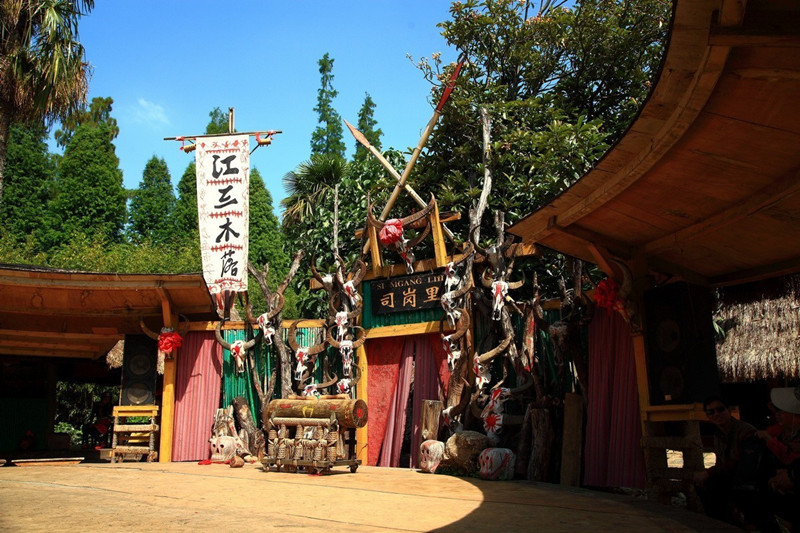
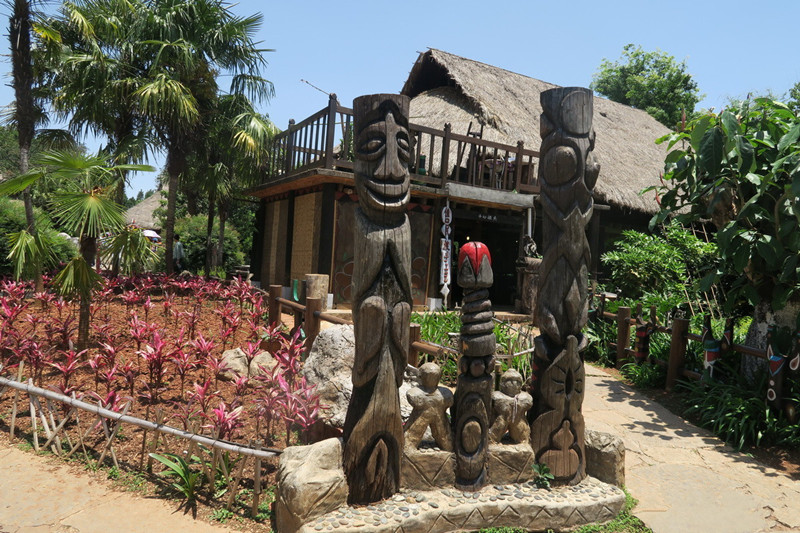
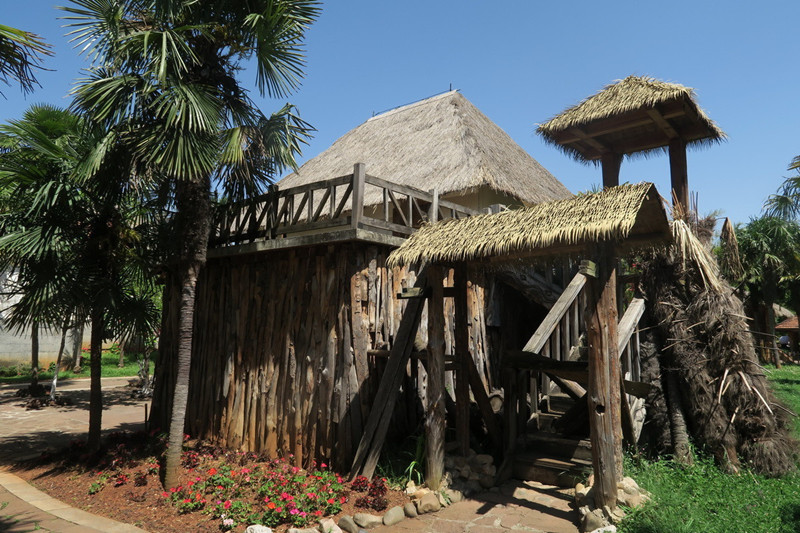
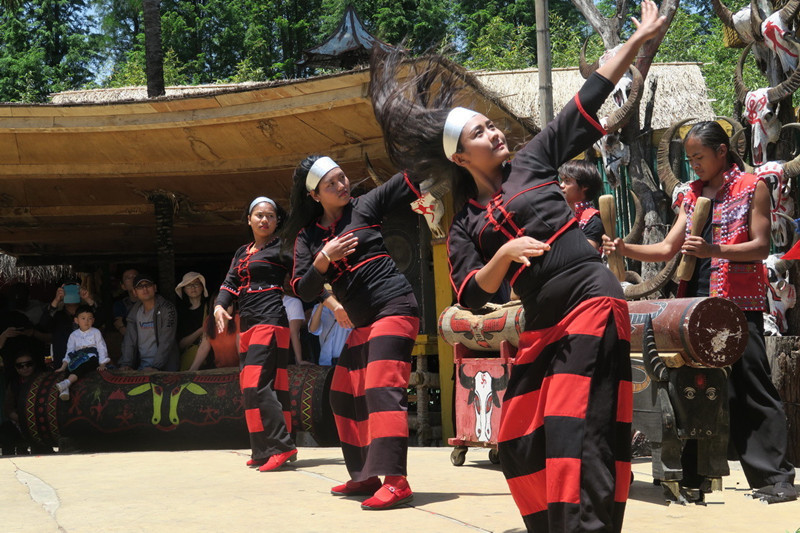
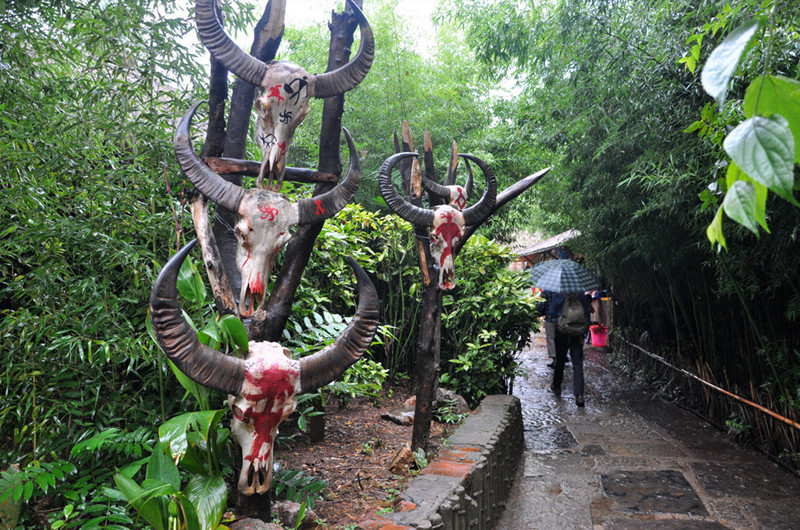

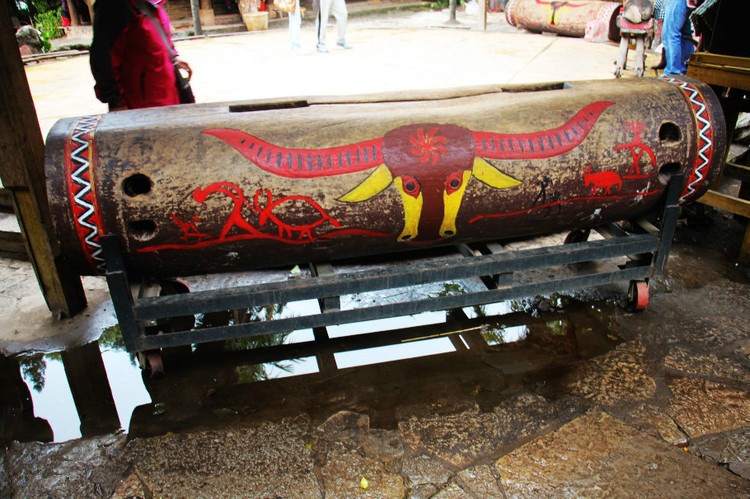
Plan your Honghe Ethnic Villages Tour to Honghe? Visit Dongzhe Village of Xizhuang Town in Jianshui County, Honghe which is one of the most fascinating ethnic villages in Honghe. Explore the local folk ethnic culture including History, Food and Dining, Clothing, Customs and Traditions, Architecture, Festivals, Crafts, Religion, Language of local ethnic people in Dongzhe Village of Xizhuang Town in Jianshui County, Honghe.
Chinese Name: 红河州建水县西庄镇东者村
English Name: Dongzhe Village of Xizhuang Town in Jianshui County, Honghe Prefecture








Ancient Villages in Yunnan
Sideng Street of Shaxi Ancient Town Dali Sideng Street of Shaxi Old Town in Jianchuan County travel guide introduces the main attractions, entrance tickets booking, The best time to...
Why is Nanhao Village So Special? Honghe River(It is called Moshajiang river in Mosha Town of Xinping County) comes from the north, and all the way south to Ailao...
Dongchuan Red Land is located in Hongtu Town (红土地镇), over 40 kilometers southwest of the Dongchuan District (东川区) in Kunming (昆明市). Within this region lies Huashitou (花石头), near the...
Plan your Kunming Ethnic Villages Tour to Kunming? Visit Hemo Village in Shilin County, Kunming which is one of the most fascinating ethnic villages in Kunming. Explore the local...
Chinese Name: 武定县狮山镇马豆沟村 English Name: Madougou Village of Shizishan Town in Wuding County, Chuxiong Madougou Village is located in the Old Town Community of Shishan Town, Wuding County, Chuxiong...
Geographical Location and Administrative Division Location: Songping Village is located in Miaowei Lisu Ethnic Township, Yunlong County, Dali Bai Autonomous Prefecture, Yunnan Province. It is situated on the eastern...
Bakalong Natural Village (坝卡龙自然村) is affiliated with Ban Zhang Village Committee (班章村委会) of Bulangshan Bulang Ethnic Township (布朗山布朗族乡), Menghai County (勐海县), Xishuangbanna Dai Autonomous Prefecture (西双版纳傣族自治州), Yunnan Province (云南省)....
Huisan Village (回伞村)is located in the southeast of Mengban Town, Mengla County, Xishuangbanna Dai Autonomous Prefecture, Yunnan Province. It is a border village under the jurisdiction of Luohui Village...
Plan your Dali Ethnic Villages Tour to Dali? Visit Jinhe Village of Xizhou Town in Xizhou Town, Dali which is one of the most fascinating ethnic villages in Dali....
Plan your Dali Ethnic Villages Tour to Dali? Visit Baofengsi Village of Daying Town in Binchuan County, Dali which is one of the most fascinating ethnic villages in Dali....
Introduction to Yunnan Ethnic Villages Yunnan Ethnic Villages (云南民族村), located on the southwestern outskirts of Kunming City (昆明市), by the shores of Dianchi Lake (滇池), covers an area of...
Plan your Honghe Ethnic Villages Tour to Honghe? Visit Dongzhe Village of Xizhuang Town in Jianshui County, Honghe which is one of the most fascinating ethnic villages in Honghe....
Don't assume you're restricted to the main hubs of Beijing and Shanghai, our tours can start from any city.
For your safety, please register with the Embassy.
Exchange some local currency for your trip
Start planning your tailor-made holiday to China by contacting one of our specialists. Once enquired, you’ll get a response within 0.5~23.5 hours.

Address: Building 4, Yifuyuan, Hehong Road, Xishan District, Kunming, Yunnan, China
Wechat/QQ: 270384698
Office Call: 86-18812220370
Email: Trip@YasoTrip.com
Facebook Page:
https://www.facebook.com/YasoTrip
Tel/WhatsApp: +8618088243690
Trip@YasoTrip.com
Daily: 9:00 am - 6:00 pm
Copyright © 2008 Yaso Trip. All rights reserved
Address: Building 4, Yifuyuan, Hehong Road, Xishan District, Kunming, Yunnan, China
Wechat/QQ: 270384698
Office Call: 86-18812220370
Email: Trip@YasoTrip.com
Facebook Page:
https://www.facebook.com/YasoTrip
Tel/WhatsApp: +8618088243690
Trip@YasoTrip.com
